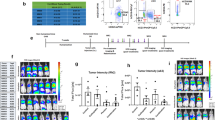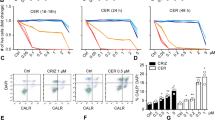Abstract
The elusive and enigmatic origin of AIDS-associated Kaposi's sarcoma (AIDS-KS) makes it a complex tumor and therefore difficult to treat. Here we demonstrate that AIDS-KS cells express surface interleukin-4 (IL-4) receptors, and that IL-4 toxin (IL-4(38-37)-PE38KDEL) is specifically cytotoxic to these cells. Intratumoral, intraperitoneal and intravenous administration of IL-4 toxin in nude mice with established subcutaneous AIDS-KS tumors caused considerable anti-tumor activity in a dose-dependent manner, with highest dose producing durable complete responses. Metabolic changes, including cachexia and lymphopenia, induced by KS tumors were prevented by IL-4 toxin treatment. This report establishes IL-4(38-37)-PE38KDEL as an experimental therapeutic agent for the treatment of AIDS-KS.
This is a preview of subscription content, access via your institution
Access options
Subscribe to this journal
Receive 12 print issues and online access
$209.00 per year
only $17.42 per issue
Buy this article
- Purchase on Springer Link
- Instant access to full article PDF
Prices may be subject to local taxes which are calculated during checkout





Similar content being viewed by others
References
Ruszczak, Z., Mayer-DaSilva, A. & Orfanos, C.E. Kaposi's sarcoma in AIDS. Multicentric angioneoplasia in early skin lesions Am. J. Dermatopathol. 9, 388–398 (1987).
Scully, P.A. et al. AIDS-related kaposi's sarcoma displays differential expression of endothelial surface antigens. Am. J Pathol. 130, 244–251 (1988).
Kaposi's sarcoma: Pathophysiology and Clinical Management (eds. Templeton, A.C. in Ziegler, J.L. & Dorfman, R.F.) 23 (M. Dekker, New York, New York, 1988).
Zhang, Y.M. et al. Vascular origin of Kaposi's sarcoma. Expression of leukocyte adhesion molecule-1, thrombomodulin, and tissue factor. Am. J. Pathol. 144, 51–59 (1994).
Staskus, K.A. et al. Kaposi's sarcoma-associated herpes virus gene expression in endothelial (spindle) tumor cells. J. Virol. 71, 715–719 (1997).
Moore, P.S. & Chang, Y. Detection of herpesvirus-like sequences in Kaposi's sarcoma in patients with and without HIV infection. N. Engl. J. Med. 332, 1181–1185 (1995).
Louie, S. et al. Effects of interleukin-1 and interleukin-1 receptor antagonist in AIDS- Kaposi's sarcoma. J. Aquir. Immune Defic. Syndr. Hum. Retrovirol. 8, 455–460 (1995).
Miles, S. A. et al. AIDS-Kaposi's sarcoma-derived cells produce and respond to interleukin 6. Proc. Natl. Acad. Sci. USA 87, 4068–4072 (1990).
Ensoli, B. et al. AIDS-Kaposi's sarcoma-derived cells express cytokines with autocrine and paracrine growth factors. Science 243, 223–226 (1989).
Weindel, K., Marme, D. & Weich, H.A. AIDS-associated Kaposi's sarcoma cells in culture express vascular endothelial growth factor. Biochem. Biophys. Res. Commun. 183, 1167–1174 (1992).
Nair, B.G. et al. Identification of major growth factor for AIDS-KS cells as oncostatin-M. Science 255, 1430– 1432 (1992).
Masood, R. et al. Vascular endothelial growth factor/vascular permeability factor is an autocrine growth factor for AIDS-Kaposi's sarcoma. Proc. Natl. Acad. Sci. USA 94, 979–984 (1997).
Maier, J.A.M. et al. Over-expression of hepatocyte growth factor in human Kaposi's sarcoma. Int. J. Cancer 65, 168– 172 (1996).
Hermans, P., Gori, A., Lemone, M., Franchioly, P. & Clumeck, N. Possible role of granulocyte-macrophage colony stimulating factor (GM-CSF) on the rapid progression of AIDS-related Kaposi's sarcoma lesions in vivo. Br. J. Haematol. 87, 413–414 (1994).
Samaniego, F., Markham, P.D., Gendelman R., Gallo, R.C. & Ensoli, B. Inflammatory cytokines induce endothelial cells to produce basic fibroblast growth factor and to promote Kaposi's sarcoma-like lesions in nude mice. J. Immunol. 158, 1887–1894 (1997).
Samaniego, F. & Gallo, R.C. in Immunology of HIV Infection (ed. Gupta, S.) 437–450 (Plenum, New York, 1996).
Lunardi-Iskandar, Y. et al. Isolation and characterization of an immortal neonatal cell line (KS Y-1) from AIDS-associated Kaposi's sarcoma. J. Natl. Cancer Inst. 87, 974–981 1995.
Lunardi-Iskandar, Y. et al. Tumorigenesis and metastasis of neoplastic Kaposi's sarcoma cell line in immunodeficient mice blocked by a human pregnancy hormone. Nature 375, 64–68 (1995).
Beral, V., Peterman, T.A., Berkelman, R.L. & Jaffe, H.W. Kaposi's sarcoma among persons with AIDS: A sexually transmitted infection. Lancet 335, 123–128 (1990).
Albini, A. et al. The β-core fragment of human chorionic gonadotropin inhibits growth of kaposi's sarcoma-derived cells and a new immortalized Kaposi's sarcoma cell line. AIDS 11, 713– 721 (1997).
Gill, P.S. et al. The effects of preparations of human chorionic gonadotropin on AIDS- related Kaposi's sarcoma (errata, N. Engl J. Med. 336, 670; 1997 and 226, 1115; 1997). N. Engl. J. Med. 335, 1261–1269 (1996).
Hermans, P. et al. AIDS-related kaposi's sarcoma patients with visceral manifestations: response to human chorionic gonadotropin preparations. J. Hum Virol. 1, 82–89 (1998).
Samaniego, F. et al. Induction of programmed cell death in Kaposi's sarcoma cells by preparations of human chorionic gonadotropin. J. Natl. Cancer Inst. 91, 135–143 (1999).
Husain, S.R., Gill, P., Kreitman, R.J., Pastan, I. & Puri, R.K. Interleukin-4 receptor expression on AIDS-associated Kaposi's sarcoma cells and their targeting by a chimeric protein comprised of circularly permuted Interleukin-4 and Pseudomonas exotoxin. Mol. Med. 3, 327–338 (1997).
Paul, W.E. Interleukin 4: a prototypic immunoregulatory lymphokine. Blood 77, 1859–1870 (1991).
Puri, R.K., & Siegel, J.P. Interleukin-4 and cancer therapy. Cancer Invest. 11, 473– 486 (1993).
Puri, R.K. Structure and functions of interleukin 4 and its receptors. in Cytokines: interleukins and their Receptors (eds, Kurzock, R. & Talpaz, M.) 143– 185 (Kluwer Academic, Norwell, Massachusetts, 1995).
Obiri, N.I., Hillman, G.G., Haas, G.P., Sudha, S. & Puri, R.K. Expression of high affinity interleukin-4 receptors on human renal cell carcinoma cells and inhibition of tumor cell growth in vitro by interleukin 4. J. Clin. Invest. 91, 83–89 (1993).
Tulpule, A. et al. Interleukin-4 in the treatment of AIDS-related Kaposi's sarcoma. Ann. Oncol. 8, 79–83 (1997).
Obiri, N.I., Siegel, J., Varricchio, F. & Puri, R.K. Expression of high-affinity IL-4 receptors on human melanoma, ovarian and breast carcinoma cells. Clin. Exp. Immunol. 95, 148–155 (1994).
Puri, R.K. et al. Preclinical development of a recombinant toxin containing circularly permuted interleukin 4 and truncated Pseudomonas exotoxin for therapy of malignant astrocytoma. Cancer Res. 56, 5631–5637 (1996).
Kreitman, R.J., Puri, R.K., & Pastan, I. A circularly permuted recombinant interleukin-4 toxin with increased activity. Proc. Natl. Acad. Sci. USA 91, 6889–6893 (1994).
Kreitman, R.J., Puri, R.K. & Pastan, I. Increased antitumor activity of circularly permuted interleukin 4-toxin in mice with interleukin 4 receptor-bearing human carcinoma. Cancer Res. 55, 3357–3363 (1995).
Puri, R.K. et al. An improved circularly permutated interleukin 4-toxin is highly cytotoxic to human renal cell carcinoma cells: Introduction of γ chain in RCC cells does not improve sensitivity. Cell. Immunol. 171, 80–86 (1996).
Husain, S.R., Behari, N., Kreitman, R.J., Pastan, I. & Puri, R.K. Complete regression of established human glioblastoma tumor xenografts by interleukin-4 toxin therapy. Cancer Res. 58, 3649–3653 (1998).
Krown, S.E. Interferon-α: Evolving therapy for AIDS-associated Kaposi's sarcoma. J. Interferon Cytokine Res. 18, 209– 214 (1998).
Pai, L.H., Wittes, R., Setser, A., Willingham, M.C. & Pastan, I. Treatment of advanced solid tumors with immunotoxin LMB-1: An antibody linked to Pseudomonas exotoxin. Nature Med. 2, 350–353 (1996).
Russell, S.M. et al. Interleukin-2 receptor γ chain: A functional component of the interleukin-4 receptor. Science 262, 1880–1883 (1993).
Kovacs, J.A. et al. Increases in CD4 T lymphocytes with intermittent courses of interleukin-2 in patients with human immunodeficiency virus infection: A preliminary study. N. Eng. J. Med. 332, 567– 575 (1995).
Kovacs, J.A. et al. Controlled trial of interleukin-2 infusions in patients infected with the human immunodeficiency virus. N. Eng. J. Med. 335, 1350–1356 (1996).
Masood, R. et al. Inhibition of AIDS-associated Kaposi's sarcoma cell growth by DAB389- interleukin 6. AIDS Res. Hu. Retro. 10, 969–975 (1994).
Cai, J. et al. IL-4R expression in AIDS-KS cells and response to rhIL-4 and IL-4 toxin (DAB389-IL-4). Invest. New Drugs 15, 279–287 (1997).
Husain, S.R. et al. Receptor for Interleukin-13 on AIDS-Kaposi's sarcoma serves as a new target for a potent Pseudomonas exotoxin-based chimeric toxic protein. Clin. Cancer Res. 3, 151– 156 (1997).
Arora N. et.al. Vascular endothelial growth facctor chimeric toxin is highly active against endothelial cells. Cancer Res. 59, 183–188 (1999).
Munson, P.J. & Rodbard, D. Ligand: a versatile computerized approach for characterization of ligand-binding systems. Anal. Biochem. 107, 220–239 (1980).
Murata, T., Noguchi, P.D. and Puri, R.K. Interleukin-13 induces phosphorylation and activation of JAK2 Janus kinase in human colon carcinoma cell lines: Similarities between interleukin-4 and 13 signalling. J. Immunol. 156, 2972–2978 (1996).
Acknowledgements
We thank J. Kassis and D. Essayan for reading the manuscript. We are indebted to P. Dover for technical assistance and procurement of reagents.
Author information
Authors and Affiliations
Corresponding author
Rights and permissions
About this article
Cite this article
Husain, S., Kreitman, R., Pastan, I. et al. Interleukin-4 receptor-directed cytotoxin therapy of AIDS-associated Kaposi's sarcoma tumors in xenograft model. Nat Med 5, 817–822 (1999). https://doi.org/10.1038/10541
Received:
Accepted:
Issue Date:
DOI: https://doi.org/10.1038/10541
This article is cited by
-
Identification of a novel role of IL-13Rα2 in human Glioblastoma multiforme: interleukin-13 mediates signal transduction through AP-1 pathway
Journal of Translational Medicine (2018)
-
Iron: a target for the management of Kaposi's sarcoma?
BMC Cancer (2004)
-
IL-4 receptors on human medulloblastoma tumours serve as a sensitive target for a circular permuted IL-4-Pseudomonas exotoxin fusion protein
British Journal of Cancer (2002)
-
Targeting AIDS-Kaposi's sarcoma
Nature Medicine (1999)



